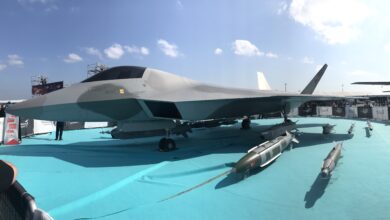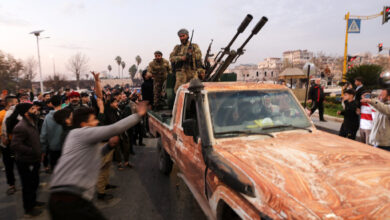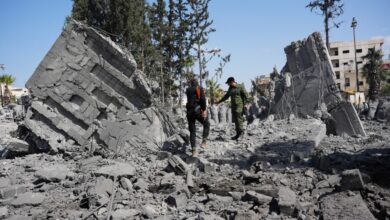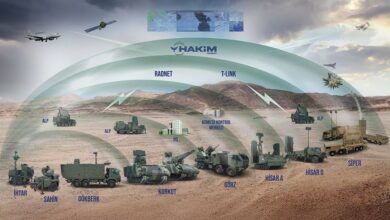US and SDF resume joint operations against ISIS sleeper cells in Syria
Northern Syrian official Aldar Xelil also says Turkish troops are amassing near Kobane, but it's uncertain if they will attack the majority-Kurdish city
By Joanne Stocker and Jared Szuba
QAMISHLI, Syria – The U.S.-led Coalition against Islamic State and Syrian Democratic Forces have begun operations against ISIS sleeper cells in northern Syria, said Aldar Xelil, a senior foreign affairs official with the TEV-DEM political movement.
Joint counter-ISIS operations began again two days ago, he told The Defense Post in an exclusive interview on Monday, November 11.
“We promised them we would return to operations against ISIS sleeper cells with them,” Xelil said, adding that “the work began two days ago.”
Backed by the U.S.-led international Coalition against ISIS, the SDF declared victory over the jihadist group after recapturing the last of its territory in Baghuz in March. And despite that defeat of ISIS’s “territorial caliphate” and killing of its leader Abu Bakr al-Baghdadi last month, sleeper cells remain in both Syria and Iraq and have launched sporadic, violent attacks in both countries.
“The Coalition’s partnership with SDF never stopped, however, the pace of raids on ISIS slowed down for a few weeks. It’s important to remember that we’re always analyzing intelligence and identifying ISIS targets around-the-clock. We will hunt down ISIS sleeper cells with SDF partners, as conditions permit,” Coalition spokesperson Colonel Myles Caggins told The Defense Post.
Xelil said the SDF still maintains good relations with the Pentagon despite tensions after President Donald Trump ordered U.S. troops to pull out of northeastern Syria, effectively greenlighting a Turkish invasion.
Trump has since said he would leave a residual force in Syria to prevent lucrative oil fields from falling into the hands of the Assad government or its Russian and Iranian partners.
More than 200,000 people have fled their homes since the October 9 incursion by Turkish forces and Turkey-backed rebels fighting under the banner of the Syrian National Army invaded northeast Syria.
Ankara considers the multi-ethnic SDF and its predominantly-Kurdish People’s Protection Units (YPG) militia to be inextricably linked to the Kurdistan Workers’ Party (PKK) that has waged a decades-long insurgency in Turkey.
But the SDF was the main Coalition partner in the war against ISIS in Syria, and the Coalition has been vocal about its support for the force in the wake of Trump’s decision.
‘There are build-ups around Kobane’
On Sunday, amid rumors of a potential Turkish attack on Kobane, a U.S. convoy was seen on the road to the majority-Kurdish city. Xelil said he didn’t know if the report that Turkey would attack Kobane was true, but “in the days before the battle of Ras al-Ayn and Tel Abyad began, there were build-ups,” and U.S. Special Envoy for Syria Engagement James Jeffrey told the SDF “there is nothing.”
“And currently there are build-ups around Kobane, but we don’t know if the attack will be carried out or not.”
Jeffrey, who is also the Envoy to the Global Coalition Against ISIS, has come under fire from critics who say his team sent conflicting messages to various sides, including European allies, throughout the Syrian border crisis in order to carry forth a strategy that ignored the stated intentions Turkish President Erdogan and Trump’s desire to bring home U.S. forces from Syria.
In a further indication that the U.S. intends to stick with the SDF, at least for now, Chairman of the Joint Chiefs of Staff General Mark Milley said on Sunday that the U.S. would keep 500 to 600 troops in Syria to counter ISIS.
“There are still ISIS fighters in the region,” Milley said, “and unless pressure is maintained, unless attention is maintained on that group, then there’s a very real possibility that conditions could be set for a re-emergence of ISIS. So we’re committed to do that,” he told ABC News.
And in a surprise joint press conference with the SDF on Monday, Caggins said the U.S. alliance with the SDF against ISIS was continuing.
But the spokesperson also said the U.S. was concentrating on eastern Syria, including Hasakah and Deir Ezzor.
“Our last base in northern Syria is the Kobane air field near Sarrin, and we will continue that deliberate withdrawal and positioning to eastern Syria,” he said.
This story was updated on November 11, 2019 at 1900 GMT with information from Coalition spokesperson Colonel Myles Caggins.












